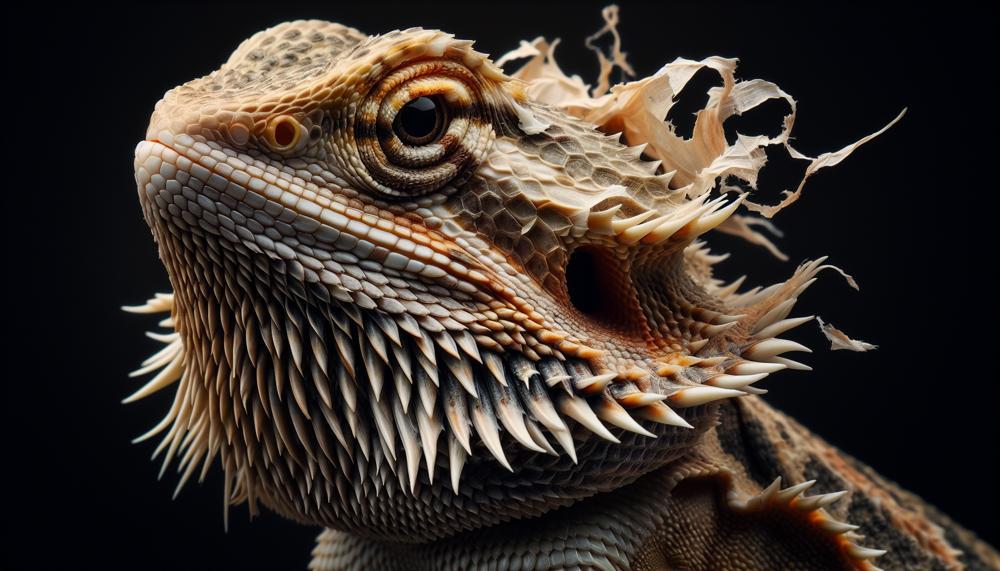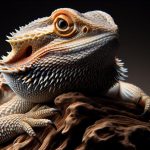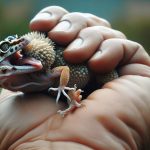Are you the proud owner of a bearded dragon? If so, then you know just how mesmerizing and unique their shedding process can be.
From their adorable little beards to their intricate patterns, there’s so much to discover about this natural phenomenon.
So, let’s jump right in and explore some key points:
- Shedding is a normal and essential process for bearded dragons to maintain healthy skin and grow.
- Younger dragons typically shed every 4-6 weeks, while adults shed every 2-3 months.
- Keep an eye out for signs that your dragon is about to shed, such as dull skin, loss of appetite, and increased aggression.
- Maintaining proper humidity levels and providing a varied diet are crucial for a smooth shedding process.
- If your dragon experiences difficulty shedding or has stuck shed, they may need assistance or have underlying health issues.
- Fun fact: the colors and patterns on a newly shed dragon can appear even more vibrant than before.
Now that we’ve sparked your curiosity, let’s dive deeper into the world of bearded dragon shedding. Are you ready to become an expert on this fascinating process?
Let’s get started.
Contents
- 1 When do bearded dragons shed?
- 2 Why Do Bearded Dragons Shed?
- 3 Bearded Dragon Shedding Process
- 4 Bearded Dragon Shedding Behavior
- 5 How To Help A Shedding Bearded Dragon
- 5.1 Ensure Proper Hydration:
- 5.2 Provide Suitable Hiding Places:
- 5.3 Maintain Optimal Temperature and Humidity:
- 5.4 Groom Your Bearded Dragon Regularly:
- 5.5 Include Moist Shedding Areas:
- 5.6 Increase Misting Frequency:
- 5.7 Give Your Bearded Dragon a Relaxing Bath:
- 5.8 Consider Using a Shedding Formula:
- 5.9 In Conclusion:
- 6 Why Is My Bearded Dragon Not Shedding?
- 7 Bearded Dragon Stuck Shed: How To Help
- 8 Conclusion
When do bearded dragons shed?
Bearded dragons shed at different rates depending on their age and life stage:
- Babies: Shed every 20–30 days
- Juveniles: Shed every 4–6 weeks
- Adults: Shed every few months
- Around 6 months: Shed every couple of weeks
- Around 12 months: Shed every couple of months
- Around 18 months: Shed a couple of times a year
Young bearded dragons shed their entire skin almost every week, while adult bearded dragons shed less often in smaller patches.
Why Do Bearded Dragons Shed?
The purpose of shedding for bearded dragons is to facilitate growth and rejuvenation of their skin. As they mature, their skin becomes tight and uncomfortable, and shedding serves to eliminate the old, dull skin and expose a fresh layer underneath.
It also helps to eliminate any parasites or bacteria that may be present on the skin.
Younger bearded dragons shed more often due to their rapid growth, with shedding occurring up to once a week. However, as they age, shedding frequency decreases, with adult bearded dragons typically shedding only 2-3 times a year.
It is crucial for owners to understand the shedding process and be prepared for it, as it is a natural and necessary aspect of a bearded dragon’s life. Changes in behavior, such as reduced activity and appetite, may indicate that a bearded dragon is preparing to shed, so owners should keep an eye out for these signs.
Providing a suitable habitat with natural decorations, proper lighting, and adequate calcium intake can help ease the shedding process for bearded dragons. Additional misting or warm baths can also assist in the shedding process if needed.
In rare instances where a bearded dragon is unable to shed properly, it is important to consult a veterinarian for assistance.
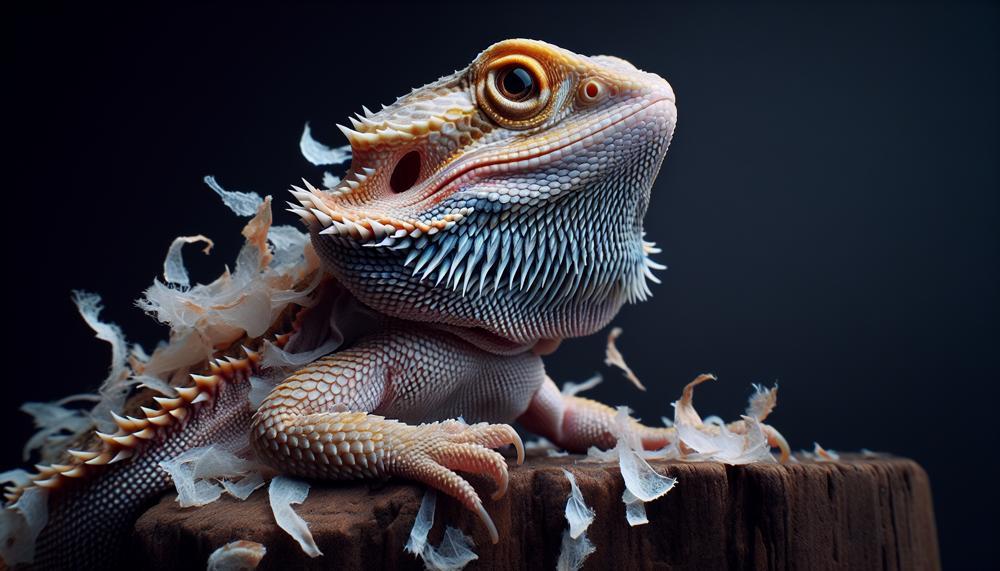
Bearded Dragon Shedding Process
As bearded dragons prepare to shed their skin, there are several indications to watch for. These include:
- Change in Skin Color and Texture: The first sign of shedding is a transformation in the color and texture of the bearded dragon’s skin. It will appear less vibrant and may have a white or greyish tint, indicating that new skin is forming underneath.
- Decreased Appetite: During the shedding process, bearded dragons may experience a decrease in appetite due to discomfort and irritation from shedding. This is typical and should not be a cause for concern unless it persists for an extended period.
- Lack of Energy: Another common sign is lethargy or lack of energy. Bearded dragons may be less active and spend more time basking or hiding during this time.
- Nervousness: As they shed, bearded dragons may become more anxious and jumpy than normal. This is because their skin is delicate, and they may feel vulnerable during this process.
- Irritability and Avoiding Handling: Due to the discomfort caused by shedding, bearded dragons may also become more irritable and avoid being handled. It is essential to give them space during this time and avoid unnecessary handling.
- Raised Patches of Skin: As new skin grows underneath, raised patches may appear on the bearded dragon’s body. These patches can manifest as small bumps or ridges and will eventually flake off with the old skin.
- Bulging Eyes: In some cases, bearded dragons may also have bulging eyes before shedding. This is due to pressure from the new skin growing underneath.
It is crucial for owners to closely monitor their bearded dragon during the shedding process and provide appropriate care to facilitate the process.
This includes maintaining proper humidity levels, offering a rough surface for them to rub against, and ensuring adequate calcium intake to promote healthy shedding.
Bearded Dragon Shedding Behavior
One of the tell-tale signs that your bearded dragon is getting ready to shed its skin is a change in color and eye appearance. You may notice that your pet’s colors appear duller or more faded, and their eyes may become cloudy or opaque. This is a natural part of the shedding process as the old skin begins to detach and make way for new growth.
In addition, you may also notice an increase in appetite and water intake in your bearded dragon. This is because shedding requires a lot of energy, and your pet will need additional nutrients and hydration to support the process.
It’s important to make sure your bearded dragon has access to fresh water at all times and provide them with a varied and nutritious diet to support their shedding needs.
Another common behavior seen in bearded dragons preparing to shed is glass surfing and scratching. This is when your pet repeatedly rubs against the walls or floor of their enclosure, trying to remove loose pieces of skin. While this may seem concerning, it is a normal behavior that helps your bearded dragon shed more efficiently.
Lastly, you may also notice changes in your bearded dragon’s overall behavior. They may become more lethargic or irritable as they focus on shedding, or they may become more reclusive and hide away in a specific spot.
These behaviors are all part of the shedding process and are nothing to worry about.
How To Help A Shedding Bearded Dragon
Shedding is a completely natural process for bearded dragons, but it can often be uncomfortable and even painful for these unique reptiles.
As a knowledgeable expert in caring for these creatures, I have gathered the following tips to help make the shedding process easier and more comfortable for your beloved bearded dragon.
Ensure Proper Hydration:
Bearded dragons require adequate hydration to maintain healthy skin and assist with shedding.
It is essential to ensure that your bearded dragon has access to clean water at all times.
Consider misting their enclosure or offering them a bath to increase moisture levels during the shedding process.
Provide Suitable Hiding Places:
During shedding, bearded dragons may feel more vulnerable and seek out hiding places.
Make sure to provide appropriate hiding spots in their enclosure, such as a rock or cave, to help them feel safe and secure.
Maintain Optimal Temperature and Humidity:
Bearded dragons need specific temperature and humidity levels to shed properly.
It is crucial to maintain a basking spot temperature of 95-105°F and a cooler side of 75-85°F. Humidity levels should be kept around 40-60%.
Regularly monitor humidity levels with a hygrometer and make adjustments as needed.
Groom Your Bearded Dragon Regularly:
Gently brushing your bearded dragon with a soft toothbrush or cloth can significantly aid in removing any excess skin and promoting proper shedding.
Avoid pulling on any loose skin, as this can cause harm and discomfort.
Include Moist Shedding Areas:
In addition to increasing humidity levels in the enclosure, you can also create a moist shedding box for your bearded dragon.
This can easily be made by filling a small container with moistened soil, moss, or paper towels, allowing your bearded dragon to burrow and rub against the textured surface to assist in shedding.
Increase Misting Frequency:
If your bearded dragon is having difficulty shedding, you may need to mist their enclosure more frequently.
Misting helps increase humidity levels and provides moisture for the skin to loosen and shed more easily.
Give Your Bearded Dragon a Relaxing Bath:
A warm bath can also be highly beneficial in softening the skin and aiding in shedding.
Fill a shallow container with lukewarm water and allow your bearded dragon to soak for 10-15 minutes. Gently massage their skin during the bath to help loosen any stubborn shed.
Consider Using a Shedding Formula:
In rare cases where your bearded dragon is struggling to shed, you can use a shedding formula to help moisturize the skin and ease the shedding process.
However, it is crucial to follow the directions carefully and only use them when necessary.
In Conclusion:
By following these helpful tips, you can assist your bearded dragon during shedding and make the process more comfortable for them.
Remember never to forcibly remove shedding skin and seek veterinary assistance if needed.
Why Is My Bearded Dragon Not Shedding?
There are several potential reasons why bearded dragons may experience difficulties with shedding their skin, and it is crucial to address them promptly to prevent potential health complications.
Some common causes of shedding issues in bearded dragons include:
- Insufficient humidity: Bearded dragons require a specific level of moisture in their habitat to shed properly. Without enough humidity, their skin can become dry and challenging to shed. To remedy this issue, make sure to regularly mist the habitat and provide a moist hide for your bearded dragon to retreat to.
- Dehydration: If your bearded dragon is not consuming enough water, it can lead to dehydration, which can interfere with the shedding process. Make sure there is always fresh water available for your pet and consider giving them a bath to encourage hydration.
- Stress: Stress can also impact the shedding process in bearded dragons. Ensure that your pet’s habitat is set up correctly and offer hiding places for them to feel safe. Avoid handling them too frequently during shedding and strive to maintain a calm and quiet environment for them.
- Inadequate nutrition: A lack of appropriate nutrition can also hinder the shedding process in bearded dragons. It is essential to provide your pet with a well-balanced diet and appropriate supplements to ensure they are receiving all the necessary nutrients for healthy skin and shedding.
In addition, if you notice that your bearded dragon has trapped shed or is not shedding at all, it may indicate an underlying health issue that should be addressed by a veterinarian.
It is important to monitor your pet’s shedding process and seek medical attention if necessary.
Bearded Dragon Stuck Shed: How To Help
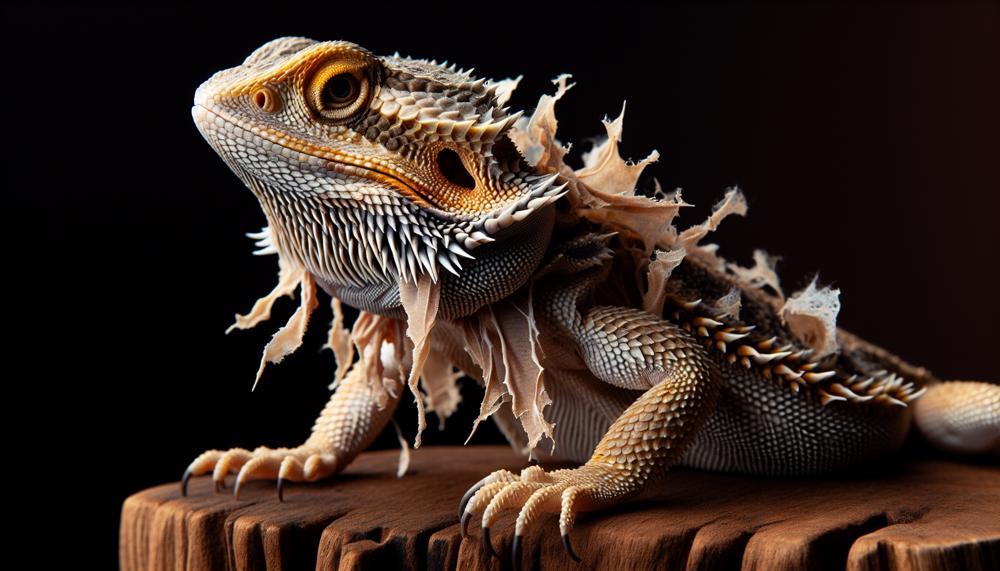
Stuck shed can be a common issue among bearded dragons, caused by factors such as low humidity, dehydration, stress, and poor nutrition. To effectively help your bearded dragon with stuck shed, there are several crucial steps you must follow.
- Avoid forcefully removing the stuck shed: It is crucial not to pull off the stuck shed as it can cause harm to your bearded dragon’s delicate skin. Instead, you can assist by placing your beardie in a warm bath for 10-15 minutes. The warm water will soften the damaged skin and make it easier to remove.
- Familiarize yourself with the shedding process: It is essential to understand the normal shedding process for bearded dragons at different stages of their life. This will enable you to identify any abnormalities or issues that may arise during shedding.
- Emulate their natural habitat: To prevent stuck shed from occurring in the first place, it is crucial to provide a suitable environment for your bearded dragon. This includes maintaining proper humidity levels, providing adequate heat and light, using the correct substrate, and regularly cleaning the enclosure.
- Maintain a balanced diet: Proper nutrition is vital for preventing deficiencies that can lead to stuck shed. Ensure to provide a well-balanced diet with essential vitamins and minerals.
- Avoid physically removing shed: It is best not to physically help remove the stuck shed as it can cause harm to your bearded dragon’s sensitive skin. Instead, you can use warm baths or specialized shedding aids such as Zoo Med Repti Shedding Aid.
- Keep the enclosure clean: Regularly cleaning the enclosure is essential for maintaining a healthy environment for your bearded dragon. Additionally, providing textured logs and rocks for your beardie to rub against can help remove excess shed.
- Watch for warning signs: If left untreated, stuck shed can lead to severe health issues such as infections or even death. Keep an eye out for warning signs such as shriveling tips of tails or dry, lackluster skin.
- Prevention is key: The best way to help your bearded dragon with stuck shed is to prevent it from happening in the first place.
Conclusion
In conclusion, shedding is a vital and fascinating process for bearded dragons. It is a natural way for them to maintain healthy skin and promote growth. However, it is not a one-size-fits-all phenomenon as younger dragons shed more frequently than adults.
Therefore, it is crucial for owners to keep a close watch on their dragon’s behavior and appearance to determine when they are preparing to shed.
Maintaining proper humidity levels and providing a varied diet are key factors in ensuring a smooth shedding process. But if any difficulties arise, don’t hesitate to seek assistance.

